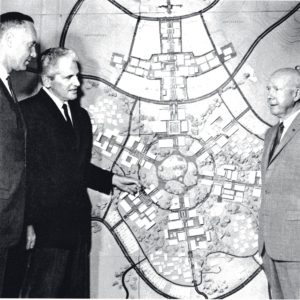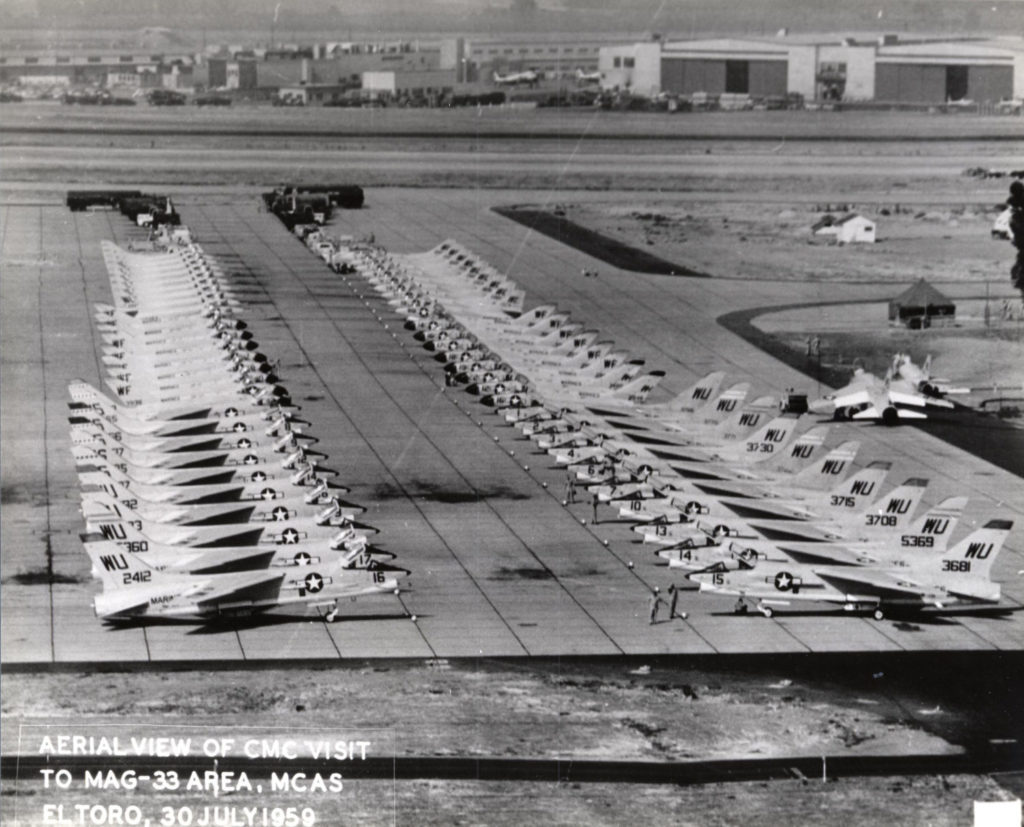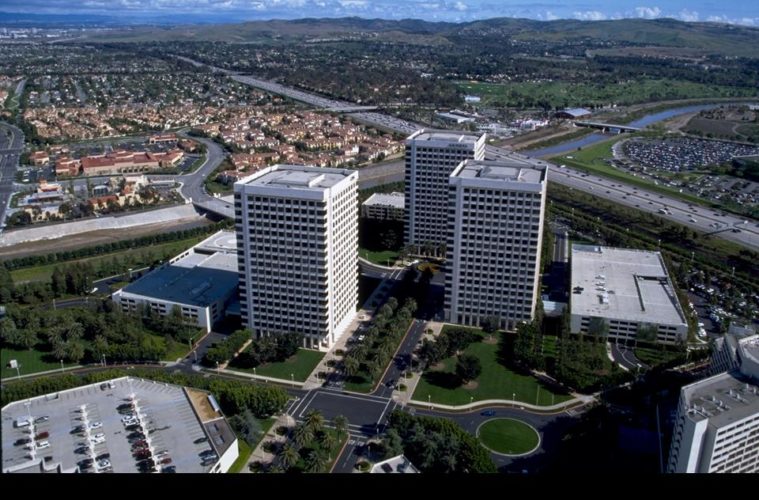At 50, Irvine can be seen as a gathering place. A cultural center. A space for local small businesses to flourish. A home to world-class education. A technology and innovation hub where companies like Google, Ingram Micro, Blizzard and Amazon have offices. A diverse community. The home of the Great Park and its iconic orange balloon. It’s a metropolitan landscape where soccer moms and dads come together to watch their children grow and entrepreneurs choose to start and grow businesses.
Some believe Irvine became a futuristic, metropolitan city by happenstance. Yet as one of the world’s most meticulously master-planned communities, the leaders that shaped the city and the people who call it home know it is no coincidence that 50 years since its founding, Irvine is flourishing now more than ever.
Fifty years ago, prior to the city’s incorporation in 1971, the city’s master plan was nothing but a glimmer in the eye of former Irvine planner Ray Watson, who would enlist the assistance of renowned architect and UC Irvine developer William Pereira.
To get a perspective on the early history of Irvine, James Myford Irvine, grandson of James Irvine II — the founder of the Irvine Company and the James Irvine Foundation — spoke to Irvine Weekly via phone on Wednesday, Dec. 16.
Born in 1953, James Myford Irvine, the son of Myford Irvine — the president of the Irvine Company for more than a decade, and Chairman of the James Irvine Foundation between 1937 – 1959, grew up living inside a home that is now the Katie Wheeler Library on Old Myford Road in Irvine.
Irvine credits the success of Irvine’s master plan, which was unveiled to the public in 1963, to his father, Myford Irvine. He added that it was several people, including William Mason, that helped in the city’s early development. Mainly, Irvine said his father’s vision for the master plan was to combat the urban sprawl of Los Angeles from reaching the Irvine Ranch.
“My father, who was president of the Irvine Company until 1959 — who knew and hired William L. Pereira to come out and design the master plan. Pereira and my father hired Raymond Watson as an assistant architect at the time. At the same time he [my father] was the head of the James Irvine Foundation — commuting between here and San Francisco,” he said. “When it was implemented it was the largest master plan in the world – no one had ever taken that large of acreage to master plan.”

Both Watson and Pereira’s work within Irvine –Watson on Irvine’s General Plan and Pereira’s on UC Irvine – would be recognized nationally with Time Magazine coverage, as many were taking note at the time of what was taking place in Southern California long before Irvine’s 50th birthday.
Over the five previous decades, though, Irvine went through many transitions. Long before it was the master-planned city with the 300,000 plus residents it houses today, it was known for pastures of rolling hills, citrus orchards and lima beans. In fact, the land we now know as Irvine was such a major agricultural site for producing lima beans that it was once a top producer of the beans globally.
But World War II changed the trajectory of the city. As a response to the attack on Pearl Harbor and resulting entry of the U.S. into World War II, the once agricultural land was swiftly transformed into Marine Corps Air Station El Toro, a base for training pilots and other military personnel, and a debarkation location for overseas deployment.

Despite the war ending, Irvine’s El Toro base remained active until its official closure in July 1999.
After the base was put to rest, the broader county community and city were at odds on what to do with the land. From airport proposals to housing developments, ideas bounced around for years – as did the political battles. But, in 2001, the future of the site was determined (by way of a ballot measure) to turn the former marine base into an ambitious park, the Great Park.
Parks have always played an important role in the fabric of Irvine. In fact, even at the inception of the University of California, Irvine, a park was at the forefront of it.
At a recent symposium celebrating the 50th anniversary of the city’s birthday, Brian Pratt, UC Irvine Associate Vice Chancellor and Campus Architect, reminded us that the school’s development plan originally drew controversy because most college campuses were centered around a quad or a plaza, but UC Irvine was to be centered around Aldrich Park.

“It was ranch land and it really took vision to imagine what could be. They embarked on this master plan that considered a park in the center – Aldrich Park – really based on some of the principles from Frederick Law Olmsted and Central Park in New York,” he said. “I have to believe that at the time nobody imagined that this plan could last and be as robust as it has proven to be as the campus has grown to over 35,000 students.”
Today, parks are synonymous with the city, but while they are part of the fabric that defines Irvine, they also come with their own set of struggles and controversies.
While Aldrich Park was controversial for its time, the early years of the development of the Great Park were wrought with controversy and tribulation. From Grand Jury investigations, to political shenanigans, to accusations of the misuse of park funds, to the 2008 great recession, many wondered if Irvine’s Great Park would ever be built and reach its potential.
In 2013, in another defining moment for the city, Irvine’s City Council approved a game-changing deal with community builder FivePoint in which the city would grant land entitlements for home construction and FivePoint would build and pay for the development of a large portion of the park, a vision that was spearheaded by FivePoint’s then-CEO Emile Haddad.

Irvine Great Park (Photo courtesy of the city of Irvine)
While parks have been commonplace in the history and growth of Irvine, so too have been home builders like Haddad with seemingly larger-than-life visions for what cities and community spaces can become. FivePoint, in recent years, has been a modern driving force in building Irvine. Earlier in the city’s history, the Irvine Company shaped the city’s housing development and its shopping experiences, like the Irvine Spectrum.
For Irvine though, the key has been sticking to its commitment to its master plan. In order for Irvine – a city that Pereira called the City of Tomorrow – to achieve the success it has today, many credit Watson and Pereira’s execution of the master plan and the strict implementation of that plan by the city over the years.
Echoing those sentiments, Jeff Davis, Vice President of the Irvine Company, while a panelist at the 50th-anniversary symposium, said, “It all goes back to that fundamental foundation that were the key components of both the Pereira’s master plan as well as the city’s general plan when it was adopted.”
Irvine Mayor Farrah Khan sees Irvine’s master plan as a “living document.”
“We probably wouldn’t be the city we are today without a master plan. That started it all and continues to help guide us,” she said. “It’s a living document.”
As the city has done many times before, its evolution continues today as it embarks on the creation of a billion-dollar medical infrastructure with City of Hope and UCI Health while continuously maintaining thousands of acres of preserved open space and natural areas through the Irvine Ranch Conservancy.
At its 50th birthday, it would seem Irvine has, in many ways, been living up to its moniker: “The city of tomorrow.”
(Tara Finley contributed to this article)
Advertising disclosure: We may receive compensation for some of the links in our stories. Thank you for supporting Irvine Weekly and our advertisers.

